6 Explosives Delivered by Drone
By Captain John-Paul Hood US Army
Student Objectives
The student will be introduced to the explosive payloads delivered by drones – especially in Ukraine – Russian conflict.
Introduction
With the recent conflicts in Syria, Nagorno-Karabach, and Ukraine, unmanned aerial systems (drones) have become the topic of concern and debate for a good reason. These small and relatively inexpensive systems continue to grow in complexity, speed, and payload carrying capacity. Citizen hobbyists of war-torn regions continue to find ways to successfully militarize group 1 UAS seeking to carry out covert aerial surveillance and, more recently, precision strikes using manufactured small yield ordinance that is common use by militaries around the world. In many cases, hobbyist drone flyers turned militant combatants have resorted to improvised explosives delivered with devastating effects on point targets.
These new tactics and techniques have become alarming and pose a real threat to the U.S. homeland. As these conflicts continue, tactics and techniques are shared through social media, giving would-be internal dissidents options for conducting terrorism and sabotage within our borders. The following chapter contains a selection of recent use cases in which drones have been successfully employed against their intended targets, using everything from simple homemade explosives to dropping mortar round and Molotov cocktails to the drone being used to loiter, hunt targets on its own, and strike swiftly at will.
Case study 6.1: Mexican Cartel members use drones to target rivals and government officials.
At the outset of 2022, Mexican cartels have begun emplacing improvised explosive devices along roadsides to slow/deter law enforcement. The cartels eventually escalated their efforts by using drones to deliver explosives more precisely in targeted attempts against their rivals.
Figure 6.1: A Picture Taken By A Drone From Above Its Intended Target.
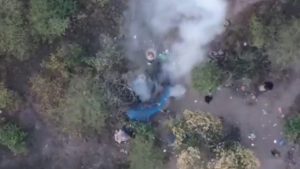
Source: (Emir, 2022)
The video, filmed with the drone’s camera, shows the drone hovering over its target and then dropping its payload of small bombs with a parachute. The footage ends when the drone loses altitude rapidly, presumably after causing at least three separate explosions. The status of possible casualties and the extent of the damage is unknown. (Emir, 2022).
Local news channels have shared the video and claimed that the Cártel de Jalisco Nueva Generación (CJNG), or Jalisco New Generation Cartel, is based in Jalisco, western Mexico, has attacked at least two towns, El Bejuco and La Romera, with drones.
CJNG, the most dangerous cartel in the country, is known for its brutality. The cartel members have been reportedly ripping out their victims’ hearts, dissolving their bodies in barrels of acid, and even targeting pregnant women. They seek to dominate the illegal but extremely lucrative narcotics traffic in the area. The CJNG has become responsible for smuggling approximately 30 percent of all illegal drugs from Mexico into the United States since its inception in 2009. (Emir, 2022)
The CJNG can call upon a wide variety of weapons, vehicles, and equipment, including camo trucks, pickups, and SUVs, some of them armed with mounted weapons and equipped with add-on armor. The cartel members are also heavily armed and provided with military-style tactical gear. Though the cartel was once loyal to the Sinaloa cartel, CJNG sought to dominate other cartels in trafficking narcotics after the capture and U.S. jailing of Sinaloa’s chief, Joaquín “El Chapo” Guzmán. (Emir, 2022)
Case Study 2: Ukraine Adapting Drones to Drop Improvised Explosives
Soon after the outset of the Russian invasion of Ukraine on February 24, 2022, the drone-owning citizens of Ukraine set out to begin arming their personal drones for military use.
Figure 6.2: Ukrainians Develop Drone That Drops Molotov Cocktails
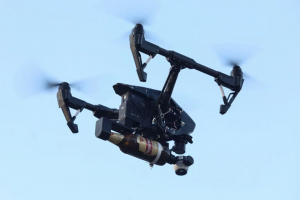
Source: (Kesslen, 2022)
Less than two weeks after Ukraine officials called on drone-owning citizens to volunteer their craft for use in defending the country from invading Russian forces, some of those non-military crafts have now been reportedly weaponized to drop Molotov cocktails on targets below. (Crumley, 2022)
The fruit of innovation, teamwork, a Soviet-era repair tradition known as “snotting things together,” in any way that works, the incendiary aerial delivery device was featured in photos in the New York Post, which failed to catch the clear markings on the UAV it says was developed by the Ukrainian Territorial Defense Forces. The Ukraine craft in the images is a DJI Inspire cinematic drone tricked out with a fastening to hold gas-filled beer bottles for dropping, one would suspect, on Russian army targets. (Crumley, 2022)
The repurposing of the drone involves the collaboration of Ukrainian Territorial Defense Forces – which has been training volunteers to the resistance against how to make and use Molotov cocktails effectively in the battle against Russian invaders in Lviv’s Pravda Brewery. However, anyone seeking to slake their thirst from the small, artsy, and decidedly patriotic maker of craft beers will have to wait while it serves the national cause. (Crumley, 2022)
“On February 24, our brewery stopped brewing beer and started making Molotov cocktails to win the war!” Pravda’s “For Molotov!” product web page informs browsing customers, “You can make a donation by purchasing a cocktail.” (Crumley, 2022)
Each bottle of flaming Molotov is 100 Ukraine Hryvnia ($3.35), and for orders of $25.12 or more, Pravda Brewery will deliver for free – now, quite possibly, by a drone above Russian forces. All by way of the adapted UAVs like the one shown in the Post’s photos. (Crumley, 2022)
The front-loaded DJI Inspire’s camera appears to be angled straight downward, possibly to offer a clear view of intended targets directly below. An L-shaped brace is affixed to the rear underside of the craft and features a downward, rimmed aperture into which the beer bottle’s mouth is slid. (Crumley, 2022)
A thin plastic band is affixed around the container’s center– possibly how it is held into place because a subsequent picture of a dropped bottle shows it falling nearly upright, indicating a rear release. Also feasible is the camera mounting has been adapted to secure the bottle’s back end. (Crumley, 2022)
Figure 6.3: Close-Up – Ukrainians Develop Drone That Drops Molotov Cocktails
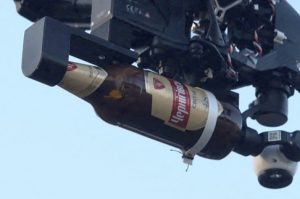
Source: (Kesslen, 2022)
Military instructors have been teaching civilians to use Molotov cocktails against the heavily armed Russian troops, and the instructions to build them reportedly have been aired on Ukrainian radio. (Kesslen, 2022)
Figure 6.4: Molotov Cocktail Released
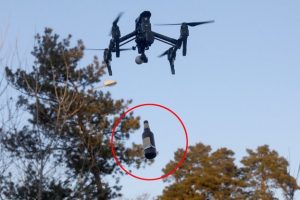
Source: (Kesslen, 2022)
Whatever the case, the use of consumer or enterprise drones by Ukrainian forces for the attack, rather than just surveillance against Russian forces, would be another indication of escalation in the fighting – and may not be the last. (Crumley, 2022)
After all, modification of UAVs to drop gas bombs on enemies might logically lead to the release system being reworked to hold the grenades or small bombs that Mexican cartels, Middle East radical groups, and foes in the battles over pro-Moscow separatist regions in east Ukraine have deployed in the past year. (Crumley, 2022)
Case Study 3: Anti-Personnel Munitions
Figure 6.5: Heavy Modifications To Civil Drone Platforms Enabled To Carry Very Low Cost Yet Powerful Munitions Such As Mortars 60-81mm Rounds.
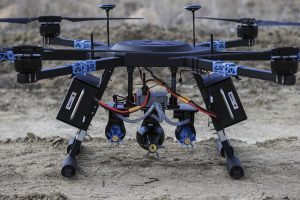
Source: (HaberDergilik/Kara-birliklernin-silahi-havan-dronla-havlandi, 2022)
The recent fighting in Ukraine has also seen the heavy modifications to civil drone platforms enabled to carry very low cost yet powerful munitions such as mortars 60-81mm rounds.
Ostim Technical University Faculty Member Prof. Dr. Sinan Kivrak and his students developed the Mortar Release System with their laboratory work. After the tests were carried out in the laboratory environment, field tests started with the system integrated into the drone. Three mortars of 60 and 81 millimeters were loaded into the release system in the test. With the command given by the remote control, the drone fired at the point determined with the non-explosive test ammunition. (HaberDergilik/Kara-birliklernin-silahi-havan-dronla-havlandi, 2022)
After the test, Kıvrak told Anadolu Agency (A.A.) that when an image is taken from any point in the field, the drone loaded with mortar can be directed to the desired coordinate and left three ammunitions with the release system. Kivrak said:
“We have developed a system that releases one 81 and two 60 mortars. There was a need in this direction, but we could not meet it. As a university and laboratory, we decided to do it ourselves. A very affordable Mortar Release System with the equipment we found on the market and the electronic control system we made ourselves. “We did it, and we made patent applications. We tested it in the process. Our system works very well.” (HaberDergilik/Kara-birliklernin-silahi-havan-dronla-havlandi, 2022)
Expressing that they cooperated with the drone manufacturer Arı Defense in the project, Kıvrak noted that the drone, which can carry 25 kilograms, stay in the air for about half an hour, and connect different payloads, is domestic with its software and hardware. (HaberDergilik/Kara-birliklernin-silahi-havan-dronla-havlandi, 2022)
Point shooting with a drone
The radiant drone will be sent, and it will drop three mortar shells on the elements visually. If you try to do it under normal conditions, it is difficult and difficult to shoot these coordinates and adjust the weapon. We will have eliminated the terrorist elements with a very simple and appropriate structure in such a system. When you consider the cost, such a system has a cost of approximately 1500-2000 T.L. (HaberDergilik/Kara-birliklernin-silahi-havan-dronla-havlandi, 2022)
We have very good works related to unmanned aerial vehicles and release systems as a country. It is heard in the world right now. Therefore, if we produce affordable and sustainable products, we will meet the needs of our own armed forces as soon as possible, and we will cure the oppressed nations as we do now.” (HaberDergilik/Kara-birliklernin-silahi-havan-dronla-havlandi, 2022)
Figure 6.6: Point Shooting with a Drone
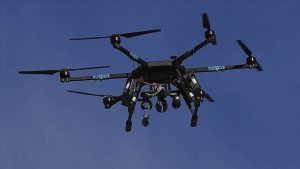
Source: (HaberDergilik/Kara-birliklernin-silahi-havan-dronla-havlandi, 2022)
Case Study 6.4: Loitering Munitions (LM or L.M.)
Figure 6.7: Russian KUB-BLA “Suicide Drone”
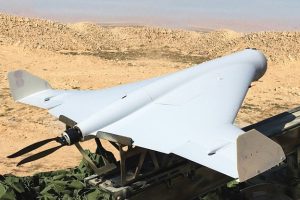
Source: (Knight, 2022)
Russia’s ZALA Aero Group, the unmanned aircraft systems (UAS) division of Kalashnikov, unveiled a “kamikaze” drone — the KUB-BLA — at the International Defense Exhibition and Conference (IDEX) in Abu Dhabi on February 17. The small UAS is designed to have a maximum speed of about 80 miles per hour, an endurance of 30 minutes, and an explosive payload of 7 pounds against “remote ground targets.” (Wolfe, 2019)
Loitering munitions can have a dwell time of up to six hours and are equipped with sensors to allow the drones to detect and attack targets independently.
“The maker of the lethal drone claims that it can identify targets using artificial intelligence.”
A RUSSIAN “SUICIDE drone” that boasts the ability to identify targets using artificial intelligence has been spotted in images of the ongoing invasion of Ukraine. (Knight, 2022)
Photographs showing what appears to be the KUB-BLA, a type of lethal drone known as a “loitering munition” sold by ZALA Aero, a subsidiary of the Russian arms company Kalashnikov, have appeared on Telegram and Twitter in recent days. The pictures show damaged drones that appear to have crashed or been shot down. (Knight, 2022)
With a wingspan of 1.2 meters, the sleek white drone resembles a small pilotless fighter jet. It is fired from a portable launch, can travel up to 130 kilometers per hour for 30 minutes, and deliberately crashes into a target, detonating a 3-kilo explosive. (Knight, 2022)
ZALA Aero, which first demoed the KUB-BLA at a Russian air show in 2019, claims in promotional material that it features “intelligent detection and recognition of objects by class and type in real-time.” (Knight, 2022)
The drone itself may do little to alter the course of the war in Ukraine, as there is no evidence that Russia is using them widely so far. But its appearance has sparked concern about the potential for A.I. to take a greater role in making lethal decisions. (Knight, 2022)
“The notion of a killer robot—where you have artificial intelligence fused with weapons—that technology is here, and it’s being used,” says Zachary Kallenborn, a research affiliate with the
National Consortium for the Study of Terrorism and Responses to Terrorism (START).
(Knight, 2022)
Figure 6.8: KUB-BLA Russian Loitering Munition
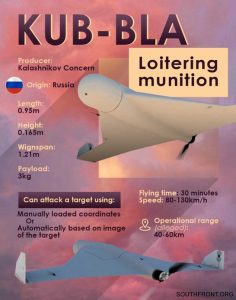
Source: (Front, 2020)
Advances in A.I. have made it easier to incorporate autonomy into weapons systems and have raised the prospect that more capable systems could eventually decide for themselves who to kill. A UN report published last year concluded that a lethal drone with this capability might have been used in the Libyan civil war. (Knight, 2022)
Figure 6.9: Russian Suicide Drone Used in Ukraine That Picks its Own Targets Though Advance A.I.
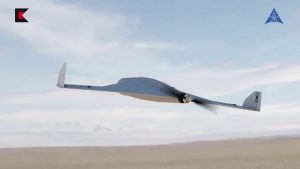
Source: (Wolfe, 2019)
It is unclear if the drone may have been operated in this way in Ukraine. One of the challenges with autonomous weapons may prove to be the difficulty of determining when full autonomy is used in a lethal context, Kallenborn says. (Knight, 2022)
The KUB-BLA images have yet to be verified by official sources, but the drone is known to be a relatively new part of Russia’s military arsenal. Its use would also be consistent with Russia’s shifting strategy in the face of the unexpectedly strong Ukrainian resistance, says Samuel Bendett, an expert on Russia’s military with the defense think tank CNA. (Knight, 2022)
Bennett says Russia has built up its drone capabilities in recent years, using them in Syria and acquiring more after Azerbaijani forces demonstrated their effectiveness against the Armenian ground military in the 2020 Nagorno-Karabakh war. “They are an extraordinarily cheap alternative to flying manned missions,” he says. “They are very effective both militarily and of course psychologically.” (Knight, 2022)
Russia seems to have used few drones in Ukraine early on, which may be due to misjudging the resistance or effective Ukrainian countermeasures. (Knight, 2022)
But drones have also highlighted a key vulnerability in Russia’s invasion, entering its third week. Ukrainian forces have used a remotely operated Turkish-made drone called the TB2 to great effect against Russian forces, shooting guided missiles at Russian missile launchers and vehicles. The paraglider-sized drone, which relies on a small crew on the ground, is slow and cannot defend itself, but it has proven effective against a surprisingly weak Russian air campaign. (Knight, 2022)
The Biden administration said it would supply Ukraine with a small US-made loitering munition called Switchblade this week. This single-use drone, equipped with explosives, cameras, and guided systems, has some autonomous capabilities but relies on a person to decide which targets to engage. (Knight, 2022)
But Bennett questions whether Russia would unleash an AI-powered drone with advanced autonomy in such a chaotic environment, especially given how poorly coordinated the country’s overall air strategy seems to be. “The Russian military and its capabilities are now being severely tested in Ukraine,” he says. “If the [human] ground forces with all their sophisticated information gathering can’t understand what’s happening on the ground, how could a drone?”
Several other military experts question the purported capabilities of the KUB-BLA. (Knight, 2022)
“The companies that produce these loitering drones talk up their autonomous features, but often the autonomy involves flight corrections and maneuvering to hit a target identified by a human operator, not autonomy in the way the international community would define an autonomous weapon,” says Michael Horowitz, a professor at the University of Pennsylvania, who keeps track of military technology. (Knight, 2022)
Despite such uncertainties, the issue of A.I. in weapons systems has become contentious because the technology is rapidly finding its way into many military systems, for example, to help interpret input from sensors. The U.S. military maintains that a person should always make lethal decisions, but the U.S. also opposes a ban on developing such systems.
To some, the appearance of the KUB-BLA shows that we are on a slippery slope toward increasing the use of A.I. in weapons that will eventually remove humans from the equation. (Knight, 2022)
“We’ll see even more proliferation of such lethal autonomous weapons unless more Western nations start supporting a ban on them,” says Max Tegmark, a professor at MIT and co-founder of the Future of Life Institute, an organization that campaigns against such weapons. (Knight, 2022)
Others, though, believe that the situation unfolding in Ukraine shows how difficult it will be to use advanced A.I. and autonomy. (Knight, 2022)
William Albergue, Director of Strategy, Technology, and Arms Control at the International Institute for Strategic Studies, says that given Ukraine’s success with the TB2, the Russians are not ready to deploy more sophisticated tech. “We’re seeing Russian morons getting owned by a system that they should not be vulnerable to.” (Knight, 2022)
Figure 6.10: The Wreckage of Another Russian KUB-BLA Loitering Munition.
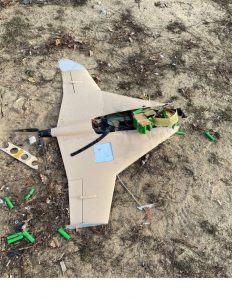
Source: 3/ (Lee) (Lee, 2022)
Figure 6.11: US Marine firing Switchblade from a pneumatic launch tube

Source: (Bowman, 2022)
On the other side, Ukraine has been thrust into the forefront of using loitering munitions in defense and is now a testbed for western observers.
Loitering munitions — essentially small suicide drones capable of tracking a target and then striking it — have been around for years. Still, technology emerged as a key weapon in the 2021 conflict between Armenia and Azerbaijan. In Ukraine’s urban warfare, the system maybe even more valuable. Two Foundation for Defense of Democracies experts explain why loitering munitions are the perfect tool for Ukraine’s resistance and what systems could be sent to Kyiv in a new op-ed. (Bowman, 2022)
Hours after, Ukrainian President Volodymyr Zelenskyy delivered an impassioned plea for help to the U.S. Congress on March 16. President Joe Biden announced that Washington will provide $800 million in additional security assistance to Ukraine, including 100 Switchblade loitering munitions (L.M.s), commonly referred to as “suicide drones.” While members of Congress have pushed for the potential transfer to Ukraine of Polish MiG-29s, the White House is wise to prioritize weapon systems that can quickly bolster Ukrainian combat capability while minimizing logistical burdens and vulnerability to Russian attack. (Bowman, 2022)
The problem, however, is Ukraine will likely expend those 100 Switchblades in mere days, and the variant of the Switchblade Washington is most likely sending is of no serious use against Russian armor. Accordingly, Washington should work with NATO allies to urgently provide Ukraine with additional shipments consisting of greater quantities and varieties of loitering munitions, or L.M.s. (Bowman, 2022)
L.M.s are a combination of missiles and aerial surveillance drones. They blend the ability to maneuver, conduct surveillance, and strike targets into a single platform, reducing the time between detection and engagement of a target. That could prove decisive for Ukrainian defenders who may encounter more close-quarters urban combat in the coming days. (Bowman, 2022)
L.M.s vary in size and capability. Loiter time above potential targets can range from minutes to hours, while their munition can be sized to target troops, equipment (with and without armor), or military infrastructure. The systems carry cameras to identify targets and transmit images back to the operator. L.M.s can be difficult for adversaries to detect and destroy because of their low radar, visual, and thermal signatures. (Bowman, 2022)
Figure 6.12: Switchblade 600
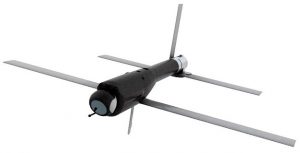
Source: (Valpolini, 2020)
Some L.M.s can be mounted on and launched from ground vehicles. Smaller versions, such as the Switchblade, can be carried even in backpacks and employed by individual soldiers. This will provide Ukrainian infantry squads with increased combat power that can be easily transported, concealed, and operated. And unlike manned aircraft and larger drones, L.M.s don’t depend on airfields for employment. That will create real problems for Russian forces, which will have to assume that any Ukrainian infantry may have this capability. (Bowman, 2022)
Ukraine has already employed some types of drones during the conflict. The Ukrainians have used their Turkish TB-2 armed drones, which are not loitering munitions, to devastating effect, as demonstrated in numerous videos on social media. Turkey provided Ukraine with a much-needed resupply of these drones during the conflict’s first week. TB-2s are quite large, with a wingspan of approximately 12 meters, and must operate from fixed airbases that can and have been targeted by Russia. (Bowman, 2022)
Ukraine has recruited drone hobbyists operating commercial drones to help address urgent military requirements for smaller drones to conduct reconnaissance. Ukrainians have sometimes resorted to jerry-rigging explosives to the bottom of commercial drones. Ukraine has even created a basic L.M. system by pairing the Punisher drone with a smaller reconnaissance drone called Spectre, which together have reportedly conducted strikes. (Bowman, 2022)
The United States and like-minded allies should immediately send more inexpensive commercial systems instead of forcing Ukraine to rely on Chinese DJI drones, which might compromise the operator’s information or be restricted from flying in certain areas via geofencing. But L.M.s can fill an important gap between the TB-2s (which rely on airfields and incur a significant logistical burden) and makeshift commercial drones that take time to prepare and are less effective than L.M.s in targeting ground forces. (Bowman, 2022)
Accordingly, the United States and like-minded allies should systematically equip the Ukrainian military with a large arsenal of purpose-built L.M.s. This is especially important because Russia may be starting to jam the command and control of TB-2 drones. Moscow has also begun to integrate better its reconnaissance and combat drones, including the ZALA KYB loitering munition. (Bowman, 2022)
There are several different L.M.s that countries willing to provide lethal aid to Ukraine have in their arsenal. The U.S., as mentioned earlier, Switchblade has seen service in Afghanistan. But while it is effective in short-range urban combat and ambushes on unarmored convoys, the Switchblade has limited range compared to some other L.M.s. And contrary to some current reporting, the Switchblade 300 variant Washington appears to be sending Ukraine (as opposed to the Switchblade 600 variant) cannot destroy most armored vehicles due to its small munition. The 100 Switchblades announced this week are only a fraction of the quantity of L.M.s that Ukraine needs. (Bowman, 2022)
So, while Congress should press the administration to send Ukraine more American-made LMs, the United States should also solicit help from other countries. Turkey operates the Kargu-2, which has seen combat in Libya, and Australia manufactures the Drone-40, both of which can be useful in an urban environment. Poland’s Warmate-series of L.M.s can strike targets out to roughly 9 km. The Warmate’s portability and range make it suitable for disrupting Russian supply convoys from a safe distance. (Bowman, 2022)
Notably, Israel operates some of the most advanced L.M. capabilities. Still, it thus far has not provided Ukraine with lethal aid, needing to tread carefully with Moscow given that Russia could hamper Israeli operations in Syria against their archenemy, Iran. Not providing military capabilities to Ukraine may also enable Jerusalem to help mediate an end to the war. However, if Israel decides to permit third-party transfers of Israeli-made weapons to Ukraine, the Harop and Orbiter L.M.s should be at the top of the list. (Bowman, 2022)
L.M.s can provide Ukraine with a robust additional capability to strike Russian forces from the air, especially as those forces linger on roads, consolidate around Ukrainian cities, or move into urban areas. L.M.s can deliver this capability in large quantities at a fraction of the cost and logistical footprint associated with operating and maintaining fighter jets or large drones. (Bowman, 2022)
The U.S. arms shipment announced Wednesday is a positive step, but it should not be the last. Working with allies, Washington should urgently send another tranche of weapons to Ukraine, and that shipment should include a greater quantity and variety of loitering munitions. (Bowman, 2022)
Figure 6.13: Artist rendition of a switchblade launch
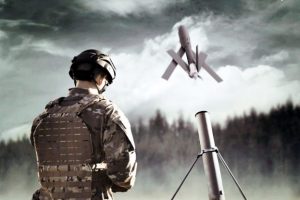
Source: (Valpolini, 2020)
The case continues to be made for developing effective countermeasures against this new and ever-evolving kind of warfare must be a priority. Lawmakers must be aware of this growing threat that, if left unchecked, these deadly autonomous systems will soon find their way into the hands of a determined individual or team who will use a drone with A.I.-backed capabilities to hunt down anyone they oppose and want to eliminate. The stuff of sci-fi lore is here today and waiting to make a major impact terribly. Common citizens use this technology to bring military juggernauts to their knees in frustration.
Thankfully, the technology does exist to counter these very real threats, and lawmakers must continue to fund their development and seek to acquire not just one solution but many. Artificial intelligence and machine learning (AI / ML) is also used in the counter-drone fight, with excellent results. Identification, classification, and sharing of information are critical in the fight. It shapes the formation of sensor networks linked to many different kinetic and non-kinetic systems. These systems will then remove drones from the sky safely and effectively with minimal to no collateral damage.
Conclusion
The conclusion is straightforward. Drones are both a perfect delivery payload for explosives, and with the use of A.I., they can be directed at any target of opportunity.
Bibliography
Bowman, R. B. (2022, March 18). Breaking Defense. Retrieved from Ukraine is getting Switchblade. It should be just the first wave of loitering munitions for Kyiv: https://breakingdefense.com/2022/03/ukraine-is-getting-switchblade-it-should-be-just-the-first-wave-of-loitering-munitions-for-kyiv/.
Crumley, B. (2022, March 11). DroneDJ. Retrieved from Ukraine reportedly adapts small drones to drop Molotov cocktails in war with Russians: https://dronedj.com/2022/03/11/ukraine-reportedly-adapts-small-drones-to-drop-molotov-cocktails-in-war-with-russians/.
Emir, C. (2022, January 13). Interesting Engineering. Retrieved from interestingengineering.com: https://interestingengineering.com/the-most-brutal-mexican-cartel-used-drones-to-drop-bombs-on-their-rival
Front, S. (2020, August 12). southfront.org. Retrieved from Russia Confirms Usage of Kalashnikov Kamikaze Drone ‘KUB-BLA’ in Syria: https://southfront.org/russia-confirms-usage-of-kalashnikov-kamikaze-drone-kub-bla-in-syria/.
HaberDergilik/Kara-birliklernin-silahi-havan-dronla-havlandi. (2022, March 20). Retrieved from ssdergilik.com: ssdergilik.com/tr/HbaerDergilik/Kara-birliklernin-silahi-havan-dronla-havanlandi
Kesslen, B. (2022, March 10). Ukrainians develop a drone that drops Molotov cocktails. Retrieved from New York Post: https://nypost-com.cdn.ampproject.org/c/s/nypost.com/2022/03/10/ukrainians-develop-drone-that-drops-molotov-cocktails/amp/
Knight, W. (2022, March 2017). Wired. Retrieved from Russia’s Killer Drone in Ukraine Raises Fears About A.I. in Warfare: https://www.wired.com/story/ai-drones-russia-ukraine/.
Lee, R. (2022, March 14). Twitter. Retrieved from Twitter @RALee85: https://twitter.com/RALee85/status/1503494100233949190?ref_src=twsrc%5Etfw
Valpolini, P. (2020, February 2). European Defense Review Magazine. Retrieved from Switchblade 600, the new Medium Range Loitering Munition: https://www.edrmagazine.eu/switchblade-600-the-new-medium-range-loitering-munition
Wolfe, F. (2019, February 21). Aviation Today. Retrieved from Russia Unveils KUB-BLA Kamikaze Drone at IDEX 2019: https://www.aviationtoday.com/2019/02/21/russia-unveils-kub-bla-kamikaze-drone-idex-2019/.

